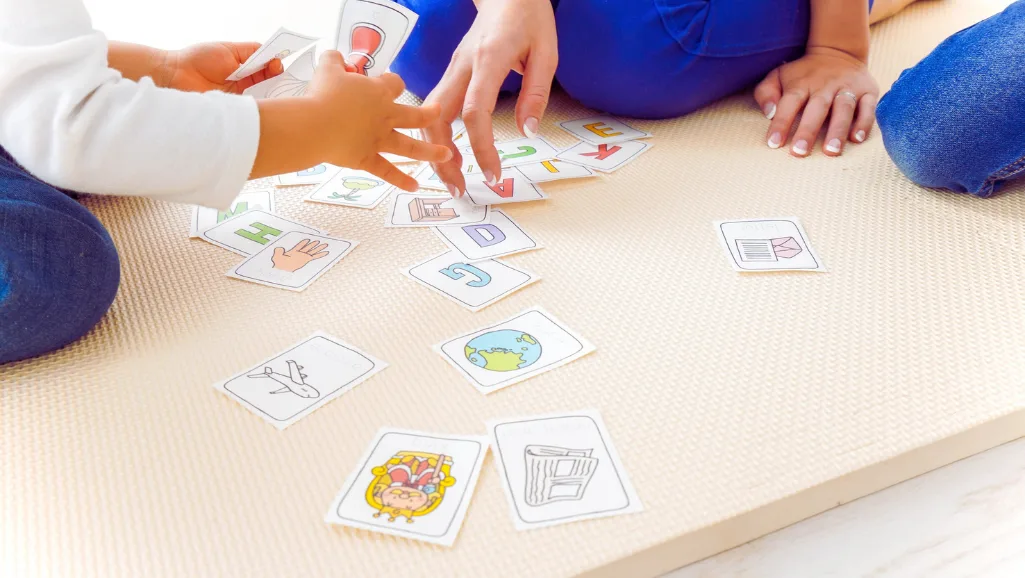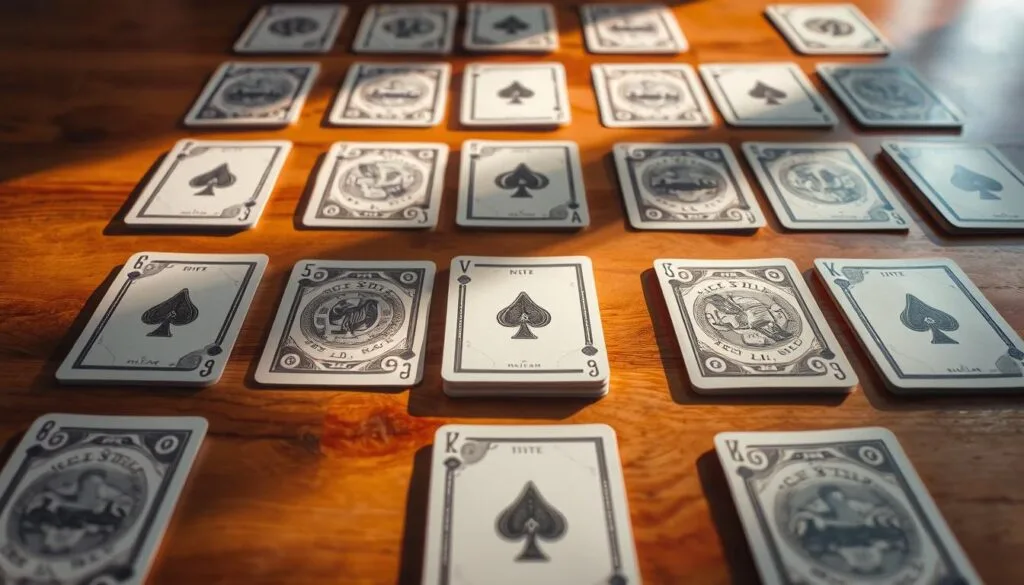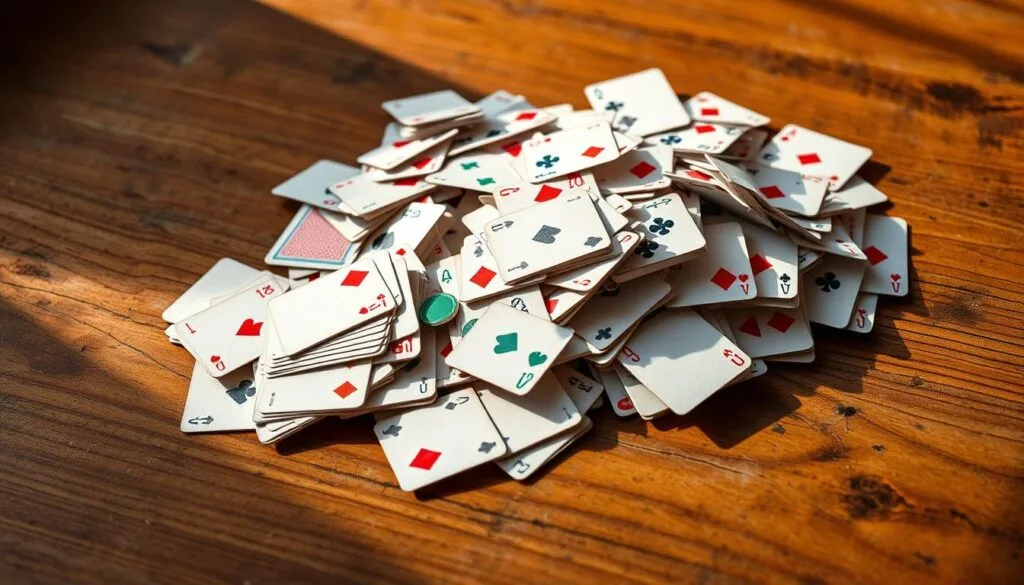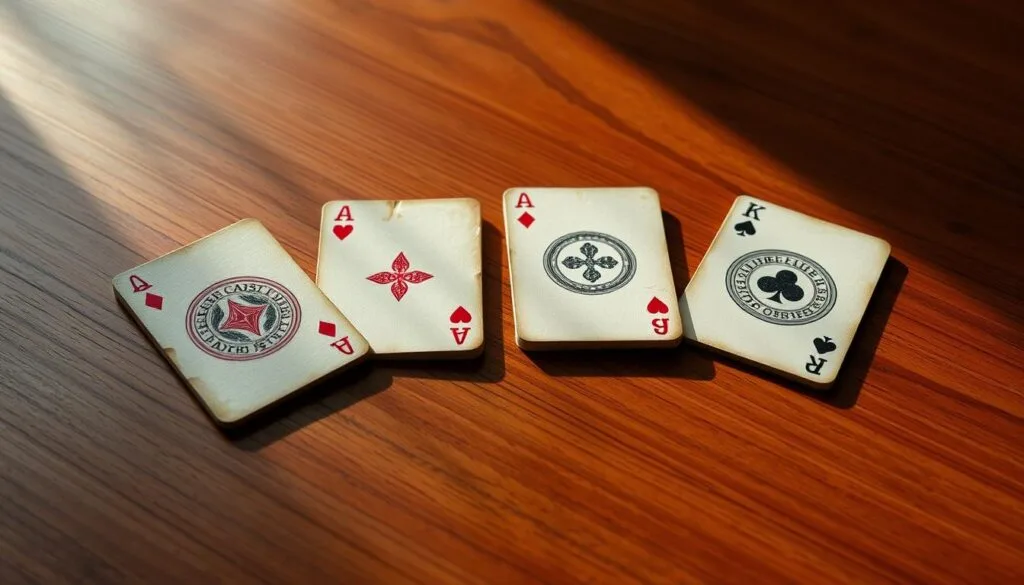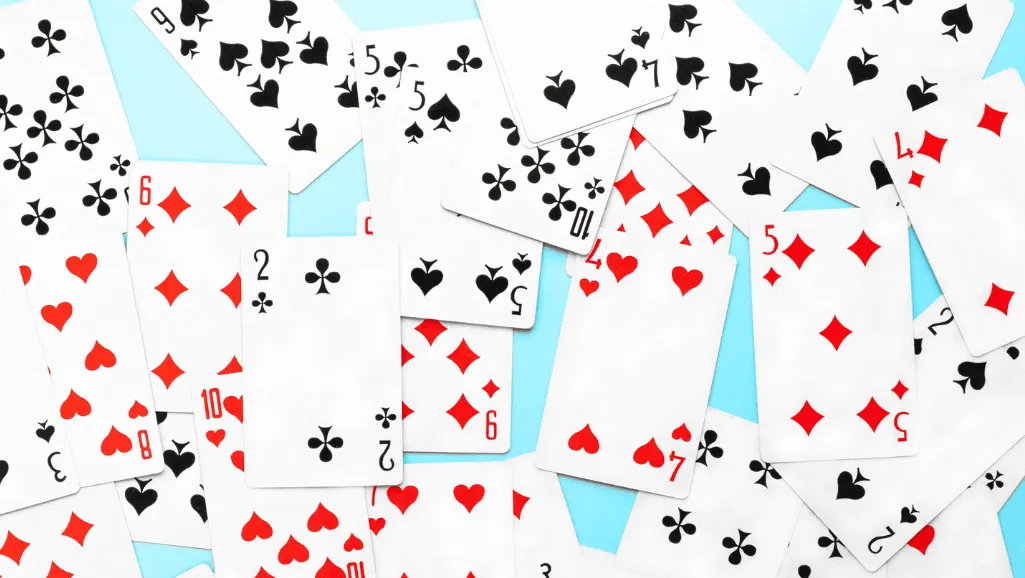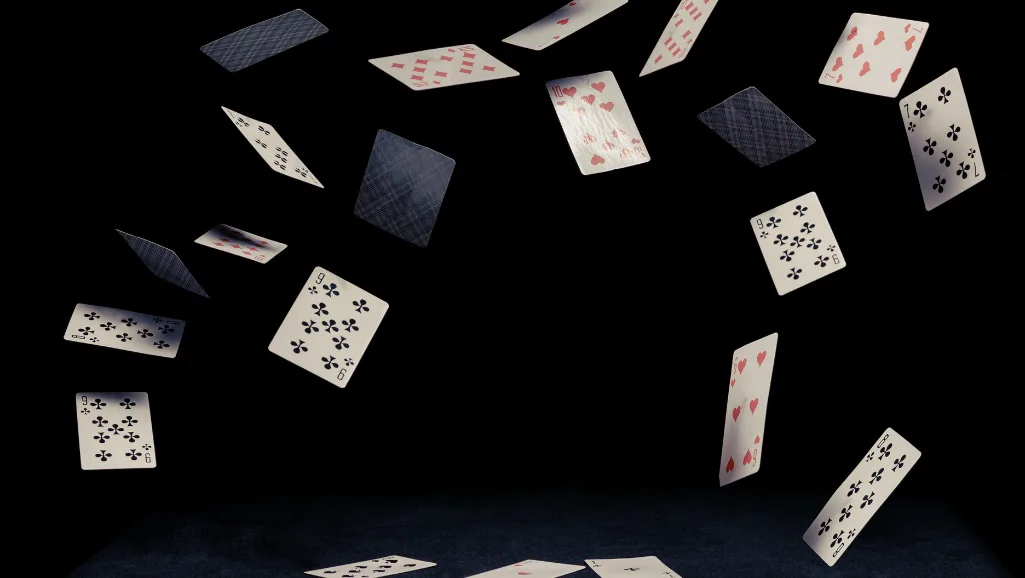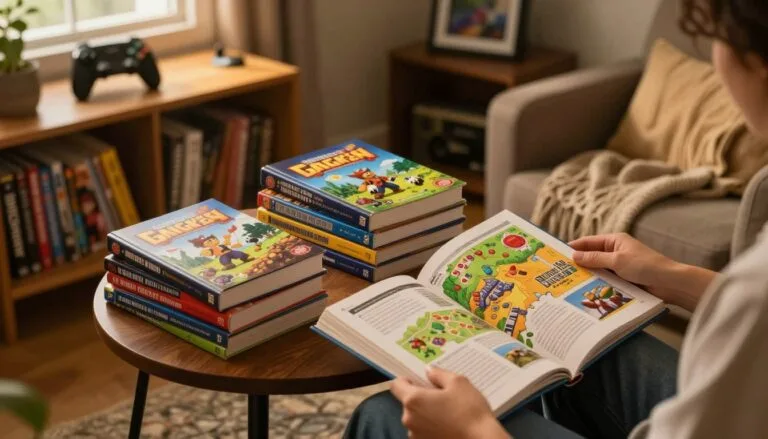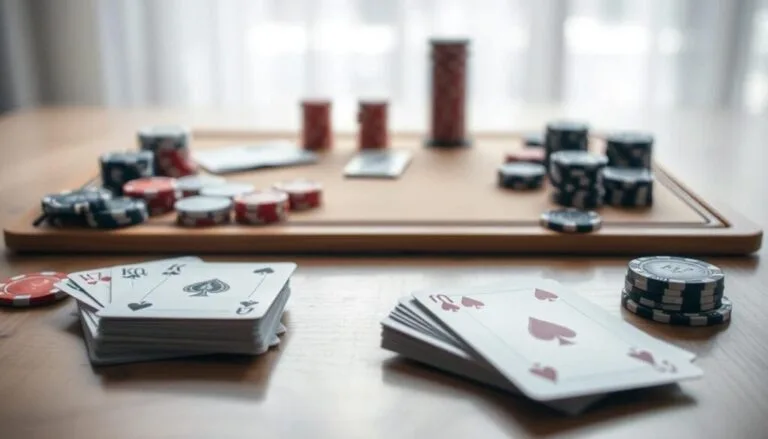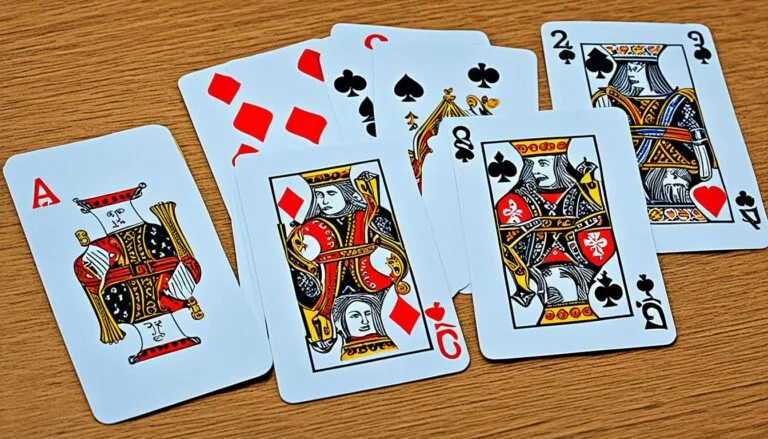Ready to learn a lively, social draw-and-discard contest that rewards quiet strategy? This guide sets a clear path from first deal to confident turns. You’ll grasp the six-card layout and the tidy 3×2 grid that shapes every choice.
On each turn, a player draws from the stock or takes the discard, then swaps into their layout or drops a card back. Two face-up cards give an early edge and help you chase the lowest score while staying flexible.
Rounds usually end when one layout shows all six cards face up. Scoring is straightforward: A=1, 2=-2, 3–10 face value, J/Q=10, K=0. Columns with matching ranks cancel to zero, a simple trick that changes the math fast.
Key Takeaways
- how to play golf card game.
- Learn the six-card, 3×2 grid quickly and use two flipped cards for early reads.
- Follow the draw-and-swap rhythm to keep tempo and reduce risk.
- Watch the pile and discard for clues; those choices shape long-term scoring.
- Pairing columns can wipe out points — aim for columns that cancel.
- Keep decisions simple: protect low cards and swap high ones when sensible.
What is Golf the card game and why it’s a great quick-play classic
Golf is a brisk draw-and-discard contest that goes by many names—Polish Polka, Polish Poker, Turtle, Hara Kiri, and Crazy Nines. The aim is simple: each player chases the lowest score over a series of hands.
Setup is fast. For two or three players a single 52-deck works; larger groups use two decks. Deal six cards to each person, place the stock and discard piles, and play clockwise from the dealer’s left.
The pace keeps everyone involved. On each turn a player draws, swaps, and flips cards face up as layouts evolve. Visible cards and the growing pile reward attention and quick reads.
Why it clicks: rules are light, rounds teach by doing, and scoring is fast so rematches come naturally. Whether you want a friendly break or a focused stretch of strategy, this guide shows a lively, repeatable game that fits any table.
Setup and equipment for a smooth first deal
Choose one or two decks based on player count and seat everyone with enough room for a neat player grid. Use a single 52-card deck for two or three players. For four or more players, switch to two decks (104 cards) so the deal stays tidy and the stock runs longer.
Shuffling and dealing the six cards
Have the cards shuffled thoroughly so ranks and suits mix well. Deal six face-down cards to each player without peeking; preserving the mystery fuels the early strategy.
Creating the stock and discard pile
Place the remaining cards face down as the stock. Flip the top card from the stock to start the visible discard pile for quick table reference.
Arranging the 3×2 grid and flipping two cards
Each player arranges their six cards into a tidy 3×2 card grid or player grid: two rows of three. Turn any two cards face up to anchor an opening plan and guide the first draw card decision.
Table position and first turn
Keep face-down cards aligned and easy to access. The player to the dealer’s left takes the first turn, and play moves clockwise. Agree on jokers and any house rules before that first turn for a smooth session.
- Quick tips: keep the pile centered for equal access and use a clean surface so cards face up are readable.
How to play golf card game step by step
Focus on one decision at a time: draw from the stock or claim the visible top card from the discard pile. Choosing the known card often beats risk, but sometimes the drawn card from stock sets up a future advantage.
Turn flow
On your turn a player may take the top card from the discard pile or draw from the stock. If you take from the discard pile, you must swap it into your layout; returning that card is not allowed.
Swap rules and revealing
Swap into any fixed position; you cannot shift cards around once placed. Replace a face-down card and the incoming card stays face up. Replace a face-up card and the replaced card goes onto the pile.
Restrictions and round end
Do not return a taken discard to the pile. If you draw from stock and the drawn card is useless, discard it instead. Rounds end when a player has all six cards face up.
- After that, most tables grant one final turn for each other player.
- Use one final turn to lower points or finish a cancelling column.
Stay calm and deliberate; steady turns win more points than risky bursts.
Scoring in Golf: from zero points to the lowest total
Every hand ends with a quick count that turns six separate cards into a single score. Know the values and you’ll evaluate every draw and swap faster.
Card values at a glance
- Ace = 1
- Two = -2
- Three through ten = face value
- Jack and Queen = 10
- King = 0
Column magic
Match a rank in a column and that column scores zero points. That trick wipes away trouble cards and swings totals quickly.
Tallying and the nine “holes”
When a round ends, flip remaining face-down cards and add each player’s six cards. Record the totals and repeat for nine hands. The winner is the one with the lowest score overall.
- Tip: Twos and kings protect your score; Jacks and Queens cost points.
- Tip: Use the pile to judge whether chasing a pair is realistic before you waste a turn.
Popular variations and house rules to try as you improve
Small tweaks can turn a familiar round into a fresh test of timing and judgment. Try a variant that fits your table—faster rounds, deeper strategy, or bigger groups can all be handled with a few clear changes.
Four-card option and knocking
Four cards uses a 2×2 grid. Each player peeks at two positions, then the first to feel confident may knock. When someone knocks, other players get one final turn.
Six-card staples
Keep the six card layout but vary flips, cancellation rules, or the final turn. Small shifts—like restricting the pile on that last move—can alter risk and reward for every player.
Nine-card depth
Deal a 3×3 grid for fuller strategy. Triplets in a column score zero points, and when any layout is fully face up the hand ends instantly. For bigger tables, use two decks to keep the pile workable.
Knocking and scoring twists
Knocking variants raise the stakes: penalties of +10 or +20 points if the knocker does not win, or a reward of zero points when they do. Add jokers for negative points, give one-eyed jacks wild powers, or set Queens and Kings to special values.
“Agree house rules before the deal so every player knows the stakes and the scoring.”
- Decide whether horizontal or diagonal cancellations count.
- Write house rules down for new players and fairness.
- Balance bonuses and penalties so skill shapes who wins game nights.
Beginner-friendly tactics to keep your score under par
Treat each draw as a chance to clarify your path toward the lowest score. Make choices that shrink risk over time. Small gains add up and protect you from a late collapse.
Smart draws and discards
Read the discard pile before you act. If the top card fits a column, take it—claiming that visible value often beats a blind draw from the stock.
If you pick from the stock and the drawn card doesn’t help, discard quickly. That cycles the pile and gives players fresh information about what ranks remain.
Grid strategy and managing high values
Use your card grid to stage moves. Park a mid card as a placeholder, then swap it when a match arrives. Target columns that can pair and zero out; one cancelled column can save many points.
Replace Jacks or Queens early unless you are one move from pairing them. Kings and Twos are precious: Kings score 0; Twos score -2.
Table awareness and planning your final turn
Watch other players and note which ranks they collect. Avoid discarding cards that complete their columns. Hold one flexible spot so your final turn can swing from risky to safe.
- Quick wins: Protect low cards, track the pile, and plan the final turn.
Common pitfalls and clarifications for first-time players
Small slips around the discard pile and face-down cards cause the biggest headaches. Learn a few simple habits and disputes vanish. These fixes keep play fair and fast for everyone.
Commitment rules matter: once you take the top card from the discard pile you must swap it into your grid. Do not return that top card. If you draw from the stock and discard instead, then flip one of your face-down cards.
Keep positions fixed. Sliding a card or revealing one accidentally leaks info and creates arguments. For four players, use two decks so the pile stays healthy and players get consistent turns.
- Clarify the end of round: when a layout is all face up, most tables give each other player one final action before tallying.
- Pairs cancel only in the same column unless house rules say otherwise.
- Pause and realign if a rule dispute appears; a short reset beats a long argument.
“Use a simple rules card at the table so new players learn the discard pile steps and flipping sequence quickly.”
Conclusion
Wrap each session by counting totals and noting small gains that add up over nine hands or until a points cap like 100 points is hit.
Use the steady rhythm—draw, evaluate, swap— as your habit. That cadence helps a player build paired columns, protect kings and twos, and shave points each hand.
Agree on session length up front: nine hands, 18, or a 100 points target. When a layout is fully revealed, most tables grant one final turn around the table so every player gets fair closure.
Keep the grid tidy and the pile readable. Track scores quickly, learn from points added by mistakes, and enjoy small improvements that decide who wins game nights.



